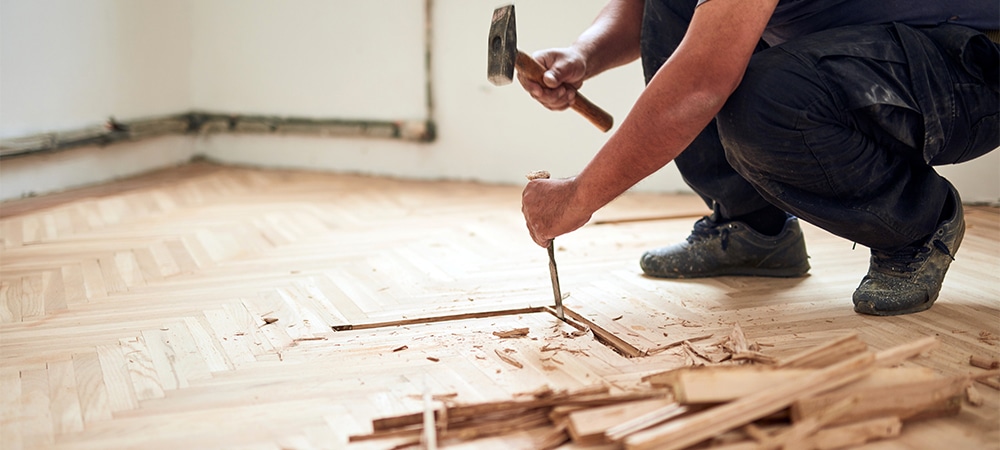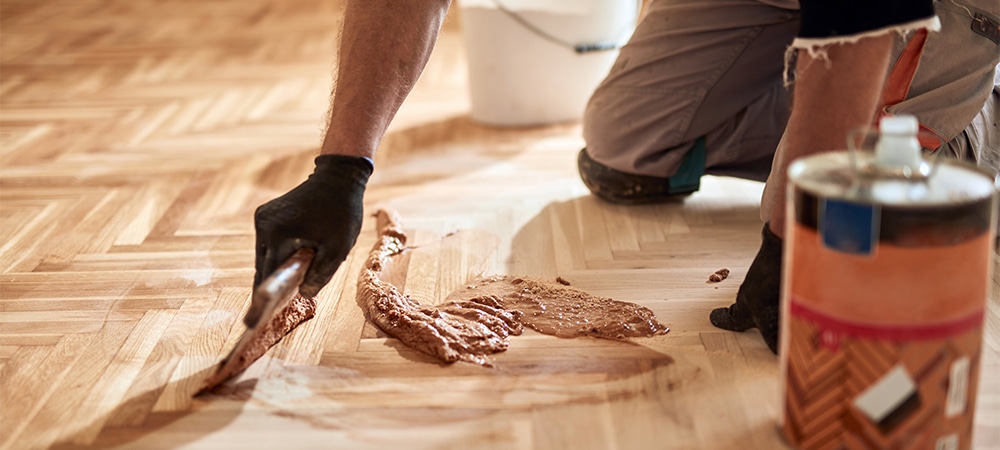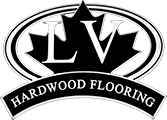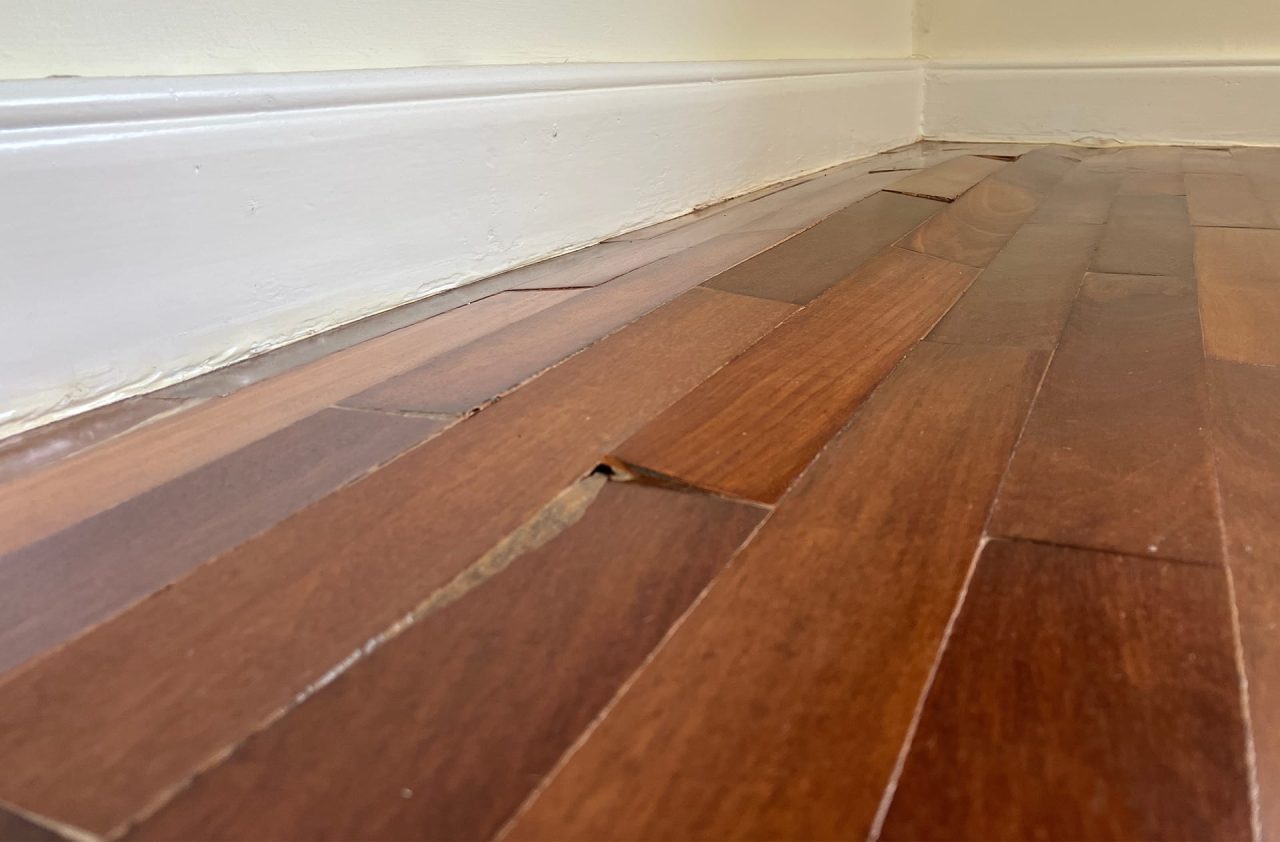Hardwood floors bring classic elegance and warmth to any home, offering enduring style and lasting beauty. They’re easy to maintain, contribute to better indoor air quality, and can increase your home’s value. But even the most durable hardwood floors aren’t immune to the damaging effects of water. Whether it’s a leaky pipe, a spilled drink, or an overflowing bathtub, water can wreak havoc on your beautiful hardwood, causing it to warp, buckle, or discolour.
In many cases, water-damaged hardwood floors can be salvaged and restored to their former glory. This blog post will guide you through the process of assessing the damage and taking the right steps to repair your hardwood floors, whether you’re a DIY enthusiast or prefer to seek professional help.
Related Article: How to Fill Gaps in Hardwood Floors
Assessing the Damage
Before you can fix your water-damaged hardwood floor, it’s essential to understand the extent and type of damage you’re dealing with. This assessment will help you determine the best course of action.
Identify the Source
The first step is to identify the source of the water damage. This is crucial to prevent further damage and resolve the problem before you begin repairs. Common sources of water damage to hardwood floors include:
- Leaks
- Spills
- Overflows
- Humidity
Related Article: What Should I Know About Installing Hardwood Floors in a Humid Climate?
Types of Water Damage
Water damage to hardwood floors can manifest in different ways:
- Surface damage: This is the most minor type of damage, affecting only the surface finish of the wood. It may appear as discolouration, staining, or slight warping.
- Cupping: Cupping occurs when the edges of the wood planks become higher than the centre, creating a concave shape. This is often caused by moisture absorption from the underside of the floorboards.
- Crowning: Crowning is the opposite of cupping, where the centre of the board is higher than the edges, creating a convex shape. This can happen when the top surface of the wood absorbs moisture.
- Buckling: Buckling is the most severe type of water damage, where the wood planks detach from the subfloor and lift upwards. This occurs when the wood expands significantly due to excessive moisture.
Related Article: How to Repair Swollen Laminate Flooring Without Replacing
Severity of Damage
Several factors influence the severity of water damage to hardwood floors:
- Amount of water: The more water involved, the greater the potential damage.
- Type of wood: Some wood species are more resistant to water damage than others.
- Duration of exposure: The longer the wood is exposed to moisture, the more severe the damage will be.
- Finish type: The type of finish on the hardwood floor can affect its susceptibility to water damage.
When to Call a Professional
While minor water damage can often be addressed with DIY repairs, there are situations where it’s best to seek professional help:
- Extensive damage
- Subfloor damage.
- Lack of experience

DIY Repair Methods for Minor Damage
If the water damage to your hardwood floor is minor, such as surface discolouration or slight cupping, you may be able to repair it yourself. Here’s a step-by-step guide:
Drying the Affected Area
Thoroughly drying the affected area is crucial before attempting any repairs. This helps to prevent further damage and allows the wood to return to its original shape.
- Remove excess water
- Increase ventilation
- Use a dehumidifier
- Avoid excessive heat
Sanding and Refinishing
If the water damage has caused discolouration or surface imperfections, sanding and refinishing the affected area may be necessary.
- Prepare the area: Clear the area and protect surrounding furniture and walls with drop cloths.
- Sand the damaged area: Start with coarse-grit sandpaper (around 60 grit) to remove the damaged finish and level any unevenness. Gradually move to finer grits (80, 100, 120) to smooth the surface.
- Clean the area: Thoroughly vacuum and wipe down the sanded area to remove any dust and debris.
- Apply stain (optional): If you want to change the colour of the wood or match the existing stain, apply a wood stain according to the manufacturer’s instructions.
- Apply sealant: Apply a protective sealant to the sanded area. Choose a sealant that is compatible with your wood type and finish preference (matte, satin, or gloss).
Wood Filler for Minor Imperfections
For minor dents or scratches caused by water damage, wood filler can be used to repair the imperfections.
- Choose the right filler: Select a wood filler that matches the colour of your hardwood floor.
- Apply the filler: Use a putty knife to apply the wood filler to the damaged area, filling the dent or scratch.
- Smooth the surface: Remove any excess filler and smooth the surface with the putty knife.
- Sand the area: Once the filler is dry, lightly sand the area to blend it with the surrounding floor.
- Apply finish: If necessary, touch up the area with matching stain and sealant to blend it with the rest of the floor.
Remember, these DIY methods are suitable for minor water damage. If the damage is extensive or you’re unsure about the repair process, it’s always best to consult a professional flooring expert.

When to Call a Professional
While DIY repairs can be effective for minor water damage, there are situations where it’s best to call in the professionals. Here are some signs that you need expert help:
Extensive Damage
If the water damage is extensive or severe, DIY repairs may not be sufficient. This includes:
- Severe cupping or crowning: If the warping of the wood is significant, it may be difficult to correct without professional equipment and expertise.
- Buckling: Buckling indicates that the wood has detached from the subfloor and requires specialized repair or replacement.
- Widespread damage: If the water damage affects a large area of your flooring, it’s best to consult a professional for a comprehensive assessment and repair plan.
Risks of Improper Repairs
Improper repairs can worsen the damage and lead to further problems, such as:
- Uneven flooring
- Mould growth
Mould or Mildew Growth
Mould or mildew growth is a serious concern and should be addressed promptly.
- Health risks: Mould can cause respiratory problems, allergies, and other health issues.
- Professional remediation: Mould remediation requires specialized knowledge and equipment to safely remove the mould and prevent its return.
Lack of Experience or Tools
If you lack experience with hardwood floor repairs or don’t have the necessary tools, it’s wise to seek professional assistance.
- Specialized tools: Hardwood floor repairs often require specialized tools, such as drum sanders, floor edgers, and moisture meters.
- Expertise: Professional flooring installers have the knowledge and experience to assess the damage accurately and perform the necessary repairs effectively.
By recognizing when to call a professional, you can ensure that your water-damaged hardwood floors are repaired correctly, preventing further damage and preserving the beauty and value of your home.
Restoring Your Hardwood Floors: From Damage to Delight
Water damage to your hardwood floors can be a stressful experience, but with the right approach, you can often restore them to their original beauty. Remember to assess the damage carefully, address the source of the moisture, and take prompt action. While DIY repairs can be effective for minor damage, don’t hesitate to seek professional help for extensive or complex issues.
At LV Hardwood Flooring, we understand the value and beauty of hardwood floors. We can help you assess the damage, provide professional repair services, or guide you towards the perfect flooring solution for your needs.
Contact LV Hardwood Flooring today for a free consultation! Let us help you restore your floors and bring back the warmth and elegance of hardwood to your home.


